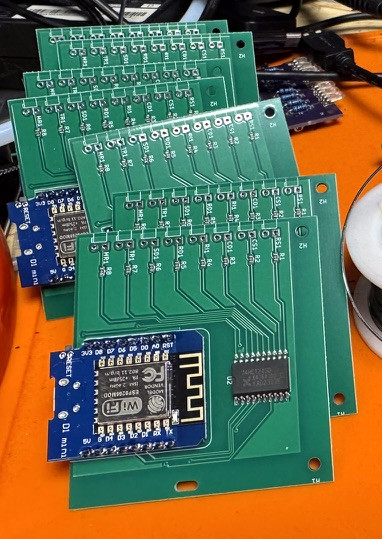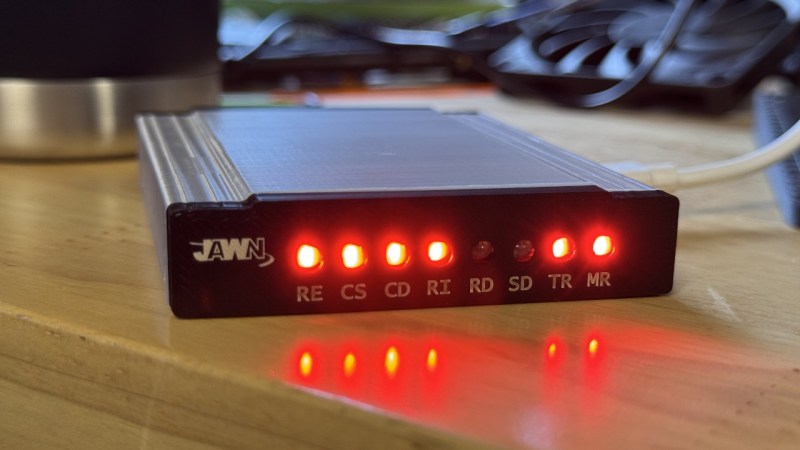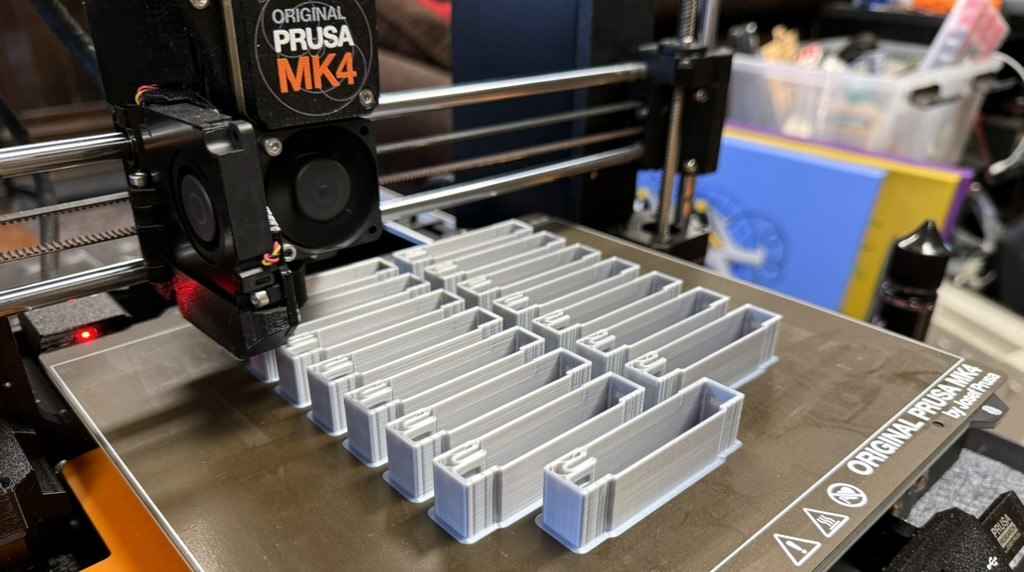For hackers of a certain age, the warbling of an analog modem remains something of a siren song. Even if you haven’t heard it in decades, the shrill tones and crunchy static are like a time machine that brings back memories of a bygone era. Alien to modern ears, in the 1980s and 90s, it was the harbinger of unlimited possibilities. An audible reminder that you were about to cross the threshold into cyberspace.
If you can still faintly hear those strangely comforting screeches in the back of your mind, the JawnCon 0x1 badge is for you. With a row of authentic vintage red LEDs and an impeccably designed 3D-printed enclosure, the badge is essentially a scaled-down replica of the Hayes SmartModem. But it doesn’t just look the part — powered by the ESP8266 and the open source RetroWiFiModem project, the badge will allow attendees to connect their modern computers to services from the early Internet via era-appropriate AT commands while they’re at the con.
 In a detailed write-up, we get a behind-the-scenes look at how the badge was designed and assembled. Being that the team is only expecting 250 or so attendees, they decided to handle production in-house. That meant printing out the cases over the course of a month and a half on a single Prusa MK4, and hand-soldering a few PCBs each day to hit their final numbers. Each front panel was also individually placed in a laser for marking, an exceptionally time-consuming process, but it’s hard to argue with those results.
In a detailed write-up, we get a behind-the-scenes look at how the badge was designed and assembled. Being that the team is only expecting 250 or so attendees, they decided to handle production in-house. That meant printing out the cases over the course of a month and a half on a single Prusa MK4, and hand-soldering a few PCBs each day to hit their final numbers. Each front panel was also individually placed in a laser for marking, an exceptionally time-consuming process, but it’s hard to argue with those results.
While the design is admittedly pushing the definition of what can realistically be called a “badge,” there’s a lanyard attached so it’s technically wearable. If the idea of being surrounded by a bunch of nerds wearing tiny modems around their necks is as enticing to you as it is to us, you’ll absolutely be among friends during this Philadelphia-area hacker con.
Although the JawnCon 0x1 badge clearly appeals to those with graying beards (literally or metaphorically), it should also provide an excellent chance for younger attendees to experience a version of the Internet that no longer exists in the real world.
The crew behind the con has spent the last few months spinning up a number of services that attendees will be able to access, including a bulletin board system (BBS), a multi-user dungeon (MUD), and a private AOL Instant Messenger (AIM) server. There’s also a selection of lo-fi websites to browse hosted on a Cobalt RaQ 4 server appliance from the year 2000. Having seen the reactions similar Internet microcosms have had while running at various Vintage Computer Festivals, we expect it should be a lot of fun for veterans and newbies alike.
We visited the inaugural JawnCon last year and came away eager for more. Judging by this look at the badge, the scheduled speakers, and the various activities set to take place during the two-day con (October 11th to the 12th), they’ve certainly delivered.
If you’re in the Philadelphia area, we highly recommend taking the ride out and experiencing the con in person. But if you can’t make it, don’t worry. We’ll be covering all the highlights of JawnCon 0x1 just as soon as we finish playing with our tiny modem.

















“While the design is admittedly pushing the definition of what can realistically be called a “badge,” there’s a lanyard attached so it’s technically wearable.”
Ehmmm… hasn’t the whole “badge” thing gotten out of hand many many moons ago. I mean Hackaday featured plenty of “badges” that contained very much technical power in the strangest shapes. That finally somebody decided to put some protective shielding around it’s parts so that it no longer is sharp or exposes it electrostatic sensitive parts or fragile glass displays, so that it is finally a product that can actually last (without being destroyed by tossing in a bag or ruined by static charges). I think that this is a huge step in the evolution of badges. Welcome to the new age. At least that’s what I thought, I could be wrong though, wouldn’t be the first time. Let’s wait and see where this is going.
So much effort put into such a sloppy RF design, what a waste. WiFi antennas need air to breathe…
So why did the designer of that wifi module put the antenna at the end of the board OPPOSITE the USB connector?
If you want to expose the USB connector at the edge of the case the, antenna gets buried inside the enclosure somewhere.
Good luck getting that to ever work out well.
Also the case is plastic & the PCB has keep-away regions in the ground planes; it works through 3 stories of a house, it’ll be fine for open conference rooms. If the case was metal it’d be a different story!
“The crew behind the con has spent the last few months spinning up a number of services that attendees will be able to access, including a bulletin board system (BBS), a multi-user dungeon (MUD), and a private AOL Instant Messenger (AIM) server. There’s also a selection of lo-fi websites to browse hosted on a Cobalt RaQ 4 server appliance from the year 2000”
So, this badge connects to these services?
Then how does the wearer connect to the badge?
LANyard. This was covered. ;)
So, following the link, and viewing the photos and diagrams, the ESP8266 has a connector (USB-C?)
to allow attendees to hook up their computers. But I didn’t see much about it.
Great looking thing. I’d love to see one of these built around an ESP32 or Pico W that can also act as a PPP router for 90s computers/PDAs to access the internet. There’s ‘theoldnet’ modem, but have found that to be stretching the limits of what the ESP8266 can handle, and have also found a SLIP firmware which works OK but then you lose access to all the Hayes commands and BBS over telnet. Yes, you can use a Raspberry Pi (e.g. Zero W) for this, but always feels like overkill.
If you’ve already got a machine somewhere with a public IP address, you can set up inetd and pppd as a sort of PPP proxy (pppd’s notty option is your friend). Then an ESP8266 can easily handle the rest.
Back in the 1980’s, I worked in a Personnel Office for an organization that employed several legally Deaf employees. We had a small teletype machine with a red LED display that was connected to a Hayes Smart Modem and a telephone land line.
One of my duties was to pick up the phone when it rang and connect it to the teletype. It was typically a Deaf person calling in to talk to another Deaf person at the work site. We would exchange greetings over the teletype and the person calling in would type in the name of the person they wanted to contact.
I would then use a regular phone in the office to call the Supervisor of the group of Deaf employees. The Supervisor had normal hearing. I would tell the Supervisor the name of the Deaf person who was being requested to come to the teletype.
A few minutes later the Deaf person would come to the Personnel Office to complete the call on the teletype. Sometimes I would observe the Deaf person at a distance while they were conducting the call even though at that range I could not see anything that was being typed.
Often, I could approximate the emotional state of the person using the teletype during the call as the keyboard was rather noisy and the person would speed up or slow down the rate of typing depending upon how they were feeling during the teletype conversation.
It is interesting that I have not thought about this memory for several years, but as soon as I saw the photo of the Hayes Smart modem, it all came back to my mind very quickly.